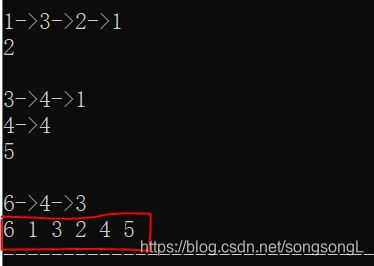1
2
3
4
5
6
7
8
9
10
11
12
13
14
15
16
17
18
19
20
21
22
23
24
25
26
27
28
29
30
31
32
33
34
35
36
37
38
39
40
41
42
43
44
45
46
47
48
49
50
51
52
53
54
55
56
57
58
59
60
61
62
63
64
65
66
67
68
69
70
71
72
73
74
75
76
77
78
79
80
81
82
83
84
85
86
87
88
89
90
91
92
93
94
95
96
97
98
99
100
101
102
103
104
105
106
107
108
109
110
111
112
113
114
115
116
117
118
119
120
121
122
123
124
125
126
127
128
129
| #include<iostream>
#include<stdlib.h>
#include<stack>
#include<queue>
using namespace std;
#define MVNum 10//最大顶点数
#define MAXINT 32768//表示极大值
typedef int arcType;
typedef char vertexType;
typedef struct MNode{
vertexType vertex[MVNum]; //存储顶点
arcType Arc[MVNum][MVNum]; //邻接矩阵,存储边
int vexnum,arcnum;
}GraphNode,*Graph;
int indegree[MVNum]={0}; //记录各个顶点的入度
int Init(Graph &G){
G=(GraphNode *)malloc(sizeof(GraphNode));
G->vexnum=0;
G->arcnum=0;
if(G) return 1;
else cout<<"初始化出错!"<<endl;
return 0;
}
void FindPos(Graph G,char a,char b,int &pos1,int &pos2){//查找位置
int i=0;
pos1=-1;pos2=-1;
for(int i=0;i<G->vexnum;i++){
if(G->vertex[i]==a){
pos1=i;
continue;
}
else if(G->vertex[i]==b){
pos2=i;
continue;
}
}
}
void CreateDG(Graph G) //创建有向图
{
int num=0, //控制输入顶点数
pos1,pos2, //确认顶点位置
i,j;
char a,
b,
ch; //顶点
for(int i=0;i<MVNum;i++){ //初始化
for(int j=0;j<MVNum;j++){
G->Arc[i][j]=0;
}
}
cout<<"请输入顶点,以#结束"<<endl;
cin>>ch;
while(ch!='#'&&num<10){
G->vertex[num]=ch;
cin>>ch;
num++;
}
G->vexnum=num;
cout<<"请输入对应的弧(ab与ba是方向相反的边),以##结束"<<endl;
cin>>a>>b;
while(a!='#'&&b!='#'){
cout<<a<<"->"<<b<<endl;
FindPos(G,a,b,pos1,pos2);
cout<<"位置a:"<<pos1<<"位置b:"<<pos2<<endl;
if(pos1!=-1&&pos2!=-1){
G->Arc[pos1][pos2]=1;
G->arcnum++;
indegree[pos2]++;
}
cin>>a>>b;
}
}
void topo(Graph G)
{
stack<int>s;
queue<int>q;
int i,temp;
for(i=0;i<G->vexnum;i++){
if(!indegree[i]) s.push(i);
}
while(!s.empty()){
temp=s.top();
q.push(temp);
s.pop();
for(i=0;i<G->vexnum;i++){
if(G->Arc[temp][i]){
indegree[i]--;
if(indegree[i]==0) s.push(i);
}
}
}
if(q.size()<G->vexnum) printf("该有向图有回路");
else{
while(!q.empty()){
printf("%c ",G->vertex[q.front()]);
q.pop();
}
}
}
void show(Graph G){
for(int i=0;i<G->vexnum;i++){
for(int j=0;j<G->vexnum;j++){
cout<<G->Arc[i][j]<<" ";
}
cout<<endl;
}
}
int main(){
Graph G = NULL;
Init(G);
CreateDG(G);
topo(G);
return 0;
}
|


